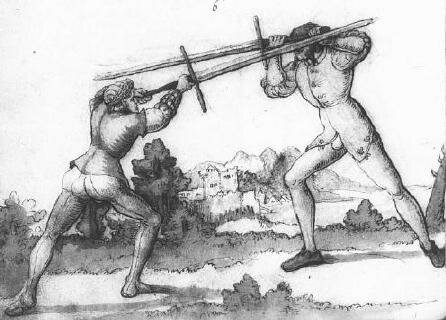

and other medieval weapons.
With these pages one rises, if he is good and gentle, to the knightly art of fencing as composed and devised by Johans Liechtenawer the one high master of the art.
Peter von Danzig, AD 1452
The focus of this site is the translation of selected sections of several fechtbücher, German manuscripts on the fighting arts. The fechtbücher examined on this site are in the tradition of 14th century master at arms Johannes Liechtenauer. Liechtenauer's (probably) unintentional gift to posterity was a series of cryptic verses describing the fighting arts, starting with longsword fencing. These verses were first written down in 1389 by a cleric named Hanko Döbringer. Döbringer apparently recorded these secret verses shortly after Liechtenauer's death in a successful effort to keep the system alive. Most longsword oriented fechtbücher right up till about 1500 were basically recitals of these verses coupled with commentary and analysis.
The translations on this site are very literal and try to stay as close to the author's original choice of words as possible. This may make the text a bit harder to read but it also allows the reader to make up his or her own mind about what the author meant. In other words, I minimise the interpretation in the translations, leaving that exersize for a separate effort.
The translations of Goliath's, Talhoffer's and Sutor's longsword sections are complete, and the Meyer and Danzig translations are well under way. Continued translating of Meyer is currently on hold.
The Goliath fechtbuch, hand-written circa 1500, is an illustrated collection of teachings similar to the unillustrated Danzig fechtbuch writen in 1452. The longsword chapter is the most detailed and verbose Liechtenauer commentary of the period. It is a great study source for the "pure" Liechtenauer style of fencing.
Joachim Meyer's fechtbuch, dated 1570, is a thorough description of the art of fencing, just like its title claims. Meyer's longsword style obviously has a Liechtenauer foundation, but he arranged the instruction text in his own way instead of just commenting on Liechtenauer's cryptic verses. Meyer's intention seemed to be to produce a training guide for the safe practice of a potentially lethal art. This gives us a good look at a sort of sport longsword style used in fencing schools and public displays. Meyer's fechtbuch, which also covers dusack, rapier, dagger, and pole weapons, was republished at intervals until 1660, a testament to its usefulness.
By examining Meyer in combination with earlier fechtbücher like Goliath, we see both the safe practice structure and the deadly foundation. I think it's a great study combination. Adding in Talhoffer and Sutor is adding paint to the walls.
Other fechtbücher are being examined and bits have been translated. They may appear eventually as time allows.
